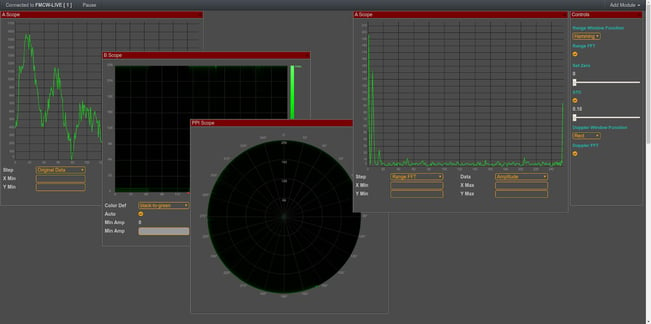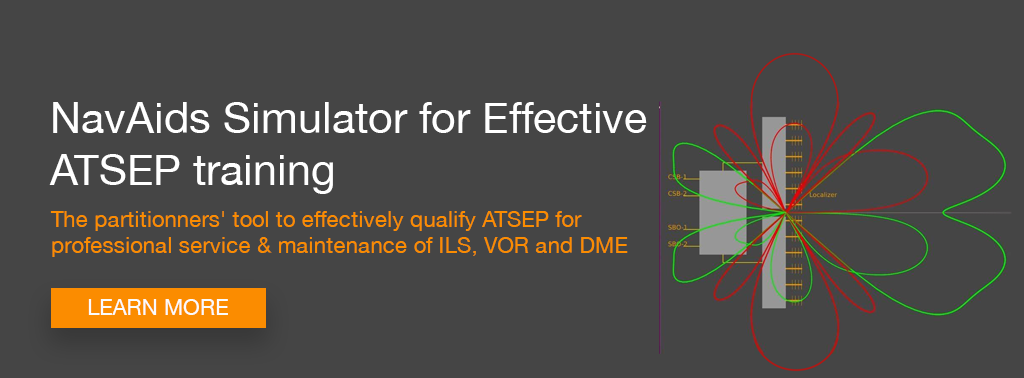This document builds on our curriculum and makes suggestions on how to teach with the SkyRadar Pulse, PSR and the FMCW.
Table of Contents
2 Theory and Practice at the example of PSR and FMCW
3 Diving Deep in Academic Substantiation and Research
Abstract
This document builds on our curriculum and makes suggestions on how to teach with the SkyRadar Pulse, PSR and the FMCW.
It is a practically oriented approach for bachelor studies in engineering universities and air traffic control personnel. The more scientific bachelor studies should complement the curriculum with more mathematical theory and substantiation.
The learning goals are defined in compliance with Bloom’s taxonomy of cognitive skills. Verbs used are based on this taxonomy.
Also, if interested in learning aids about Artificial Intelligence related to radar technology or on Navigation Aids, please contact us for related information.
Concept of this Document
The term “curriculum” refers to the overall content, taught in the frame of University of ATC education and qualification. The syllabus varies from teacher to teacher, whereas the curriculum is the same for all teachers.
In University and ATC training, the subjects taught are generally the same. However it is the learning objectives, the depth and the level of theory that differs. In ATC, we rather focus on the acquisition of a certain skill-set (still aiming for high level in Bloom’s taxonomy of cognitive skills (knowledge, comprehension, application, analysis, and to a limited extend synthesis and evaluation level) to allow for flexibility and change during the development phases).
At the university level (Bachelor), we advise to dive deeper into the mathematical background. Learning objectives are not limited to the acquisition of skills, but also require strong academic methodical skills. In Bloom’s taxonomy, this means there is a stronger focus on the synthesis and evaluation level. Knowledge should be substantiated, physical effects (such as the radar equation) should be mathematically validated.
We strongly advocate to use a blended learning, even constructivist approach, leading to a much faster and deeper acquisition of the required skill sets.
For master levels, we provide open APIs and clients, allowing to extract radar data like I/Q data in its raw form, to experiment on it, develop own filters, and experiment on staging of filtering and amplification.
Universities can embed the courses into SCORM-based learning management systems like the open-source tool Moodle (www.Moodle.org).
This section is mainly theoretical, supported by the chapters from our student hand-outs as listed below. In the forthcoming sections, we will always list the related student documentation, indicated with brackets ( … ) after the suggested learning subject. Learning subjects are always indicated with a “*” in the beginning.
When we refer to Pulse, PSR and FMCW radar, we refer to the hyperlinked SkyRadar products.
1 Introduction
This is the first introductory section in the manual that complements our suggested curriculum. It rolls out the playing field for all subsequent exercises.
We will address the learners’ knowledge level. The successful student will recognize or recall learned information. He or she will be able to recall, define and memorize the basic foundations of radar technology around aviation. In subsequent sections, the learner will consolidate the knowledge and climb up further in the hierarchy.
* Basic Principle of Operation (Radar Basics 1.1)
* Primary Radars in Air Traffic Control (Radar Basics 1.4 )
* Classification of Radar Sets (Radar Basics 1.6)
For ATC level (ATSEP and ATCO), a basic mathematical introduction will be sufficient. The focus should be on the working principles, which should be graphically. The students’ manuals as well as the teacher slides give a strong tool set.
For the university students, the learning objectives need to be more mathematically substantiated.
2 Learning the Basics with the 8 GHz Pulse or 24 GHz PSR-base module
The strongest and most efficient way of learning is a blended learning approach, making use of multiple inputs, in this curriculum the theory, documentation, teachers guidance and explanation but also the radar solutions, giving each student direct access to the system.
Depending on the teachers’ syllabus, the approach will be either more instructor-led or more constructivist, Constructivist teaching is based on the belief that learning occurs as learners are actively involved in a process of meaning and knowledge construction as opposed to passively receiving information.
We suggest to first introduce into the PSR, to give a face to the theory learned in section 1.
The pulsed radar manual will be a good document to hand-out. And the PSR radar should be visible, touchable, close to the students.
* Pulsed Radars (Pulse and PSR Manual, FreeScopes Manual, Pulse and PSR Training Exercise Manual). We suggest to first familiarize with the scopes of the radar. That will make it easy to apply and substantiate the underlying theory in a subsequent step. Substantiating theory through experiments and hands-on work with the radar scopes or / and the radar itself.
We suggest to start working with the scopes, placing the moving target position system into the aperture of the radar, and placing a reflecting object, e.g., a sphere.
Students start using the FreeScopes interface and work on the scopes, filters and amplifiers.
The experiments 1-5 of the PSR base unit training exercise manual will help.
We will cover the knowledge, comprehension and application level around the next topics, allowing the students to memorize, describe, apply the major tasks around scopes. Also they will be able to describe, analyze and diagnose the results seen on the scopes.
* A-Scope (Pulse & PSR Manual, FreeScopes Manual, Pulse & PSR Training Exercise Manual)
* B-Scope (Pulse & PSR Manual, FreeScopes Manual, Pulse & PSR Training Exercise Manual)
* Plan Position Indicator (PPI) (Pulse & PSR Manual, FreeScopes Manual, Pulse & PSR Training Exercise Manual)
* Range resolution (Pulse & PSR Training Exercise Manual)
* Sensitivity Time Control STC (Pulse & PSR Training Exercise Manual)
* Effect of Noise (Pulse & PSR Training Exercise Manual)
* Threshold function (Pulse & PSR Training Exercise Manual)
In the next level the student is expected to substantiate major features of the radar equation, allowing the student to reach synthesis and evaluation level and evaluate the validity of the radar related theory.
* Radar Equation (Radar Basics 1.2)
* Time/Distance Relation (Reporting)
* Radar Cross Section (Radar Basics 1.3)
The student will dive deeper into the theory of signal processing.
* Radar Signal Processing (Radar Basic 2.4.1-2)
* IQ Signal Processing (PSR Base Unit Training Exercise Manual, exercise 6)
* Radar Receiver (Radar Basics 2.3.1)
* Filters (Radar Basics 2.3.3)
* Sensibility
* Parabolic Reflectors ((PSR Base Unit Training Exercise Manual, exercise 8)
Introducing the FMCW
To round up the introduction of the major radars we suggest to take a look at the FMCW radar with its FMCW and Doppler mode. The student will understand the difference between a PSR and an FMCW radar. He or she can similarly to the exercises on the PSR first familiarize with the scopes and the radar itself. The student shall simply start by placing a sphere on the mobile target positioning system into the aperture of the radar and try to focus it.
The student will reach the levels of knowledge and comprehension, able to describe the FMCW radar, to explain the major differentiating points from the PSR radar. University students will have a deeper look at wave theory, comparing pulse approaches with frequency modulation. In the end they should be able to the advantages and disadvantages.
* FMCW Radars (FMCW Manual)
* Doppler Radars (FMCW Manual)
The student will experiment on the radar, following the guidance in the exercise manual and the instructor. The exercises concerning SAR will only apply to those schools which also possess the SkyRadar SAR system.
The student will be able to apply the FMCA / Doppler Radar modes and solve exercises including range, wave forms, range and speed as well as frequency.
* Range Resolution (FMCW Base Unit Training Exercise Manual)
* SawTooth Modulation and the Effect (FMCW Base Unit Training Exercise Manual)
* Range and Speed (FMCW Base Unit Training Exercise Manual)
* Frequency of Vibration (FMCW Base Unit Training Exercise Manual)
Theory and Practice at the example of Pulse, PSR and FMCW
The 4. section of the curriculum enlarges the technical skills around radar technology, introducing the technologies of tracking. The exercises can be made with both radars.
The student will be able to apply radar tracking features and inspect the trajectory of a target.
* Radar Antenna and Tracking Antenna (Radar Basics 2.1.1-2, Pulse & PSR Base Unit Training Exercise Manual exercise 7)
In the last section of section 4, the student will dive deeper into radar theory. He or she will be able to describe antenna diagram, and to explain transmitter technology. In addition he or she will be able to describe the concept of coherence.
* Antenna Diagram
* Radar Transmitter (Radar Basics 2.2.1)
* Concept of Coherence (Radar Basics 2.2.2)
Diving Deep in Academic Substantiation and Research
Master and PhD students can address the VCO directly, insert specific waveforms.
Comfortable GUIs are provided to do so.
Also, the IQ data can be extracted to build own filters and amplifiers. The sequence of filters and amplifiers will impact the measured result.
Annex
Documentation
Preparation of Teaching
Radar Basics 1.0.docx History of Radar ......................................................... 1
Radar Basics 1.1.docx Basic principle of operation ...................................... 2
Radar Basics 1.2.docx Radar Equation ............................................................. 3
Radar Basics 1.3.docx Radar Cross Section ................................................... 4
Radar Basics 1.4.docx Primary Radar in Air Traffic Management ................ 5
Radar Basics 1.5.docx Over–The–Horizon Radars ........................................... 6
Radar Basics 1.6.docx Classification of Radar Sets ...................................... 7
Radar Basics 2.1.1.docx Radar Antenna .......................................................... 8
Radar Basics 2.1.2.docx Tracking Radar Antenna ........................................... 9
Radar Basics 2.1.3.docx Radar Antenna with Synthetic Aperture ................ 10
Radar Basics 2.2.1.docx Radar Transmitter ..................................................... 11
Radar Basics 2.2.2.docx Concept of Coherence ........................................... 12
Radar Basics 2.2.3.docx Intrapulse Modulation .............................................. 13
Radar Basics 2.3.1.docx Radar Receiver ........................................................ 14
Radar Basics 2.3.2.docx Superheterodyne Principle ...................................... 15
Radar Basics 2.3.3.docx Matched Filter /Matched Receiver ......................... 16
Radar Basics 2.4.1.docx Radar Signal Processing ........................................ 17
Radar Basics 2.4.2.docx Digital Signal Processing ......................................... 18
Radar Basics 2.4.3.docx Local Tracking .......................................................... 19
Radar Basics 2.5.1.docx Radar Displays ......................................................... 20
Radar Basics 2.5.2.docx Plan Position Indicator ............................................ 21
Radar Basics 3.1.docx Electronic War ............................................................. 22
Radar Basics 4.1.docx Practical Training ......................................................... 23








